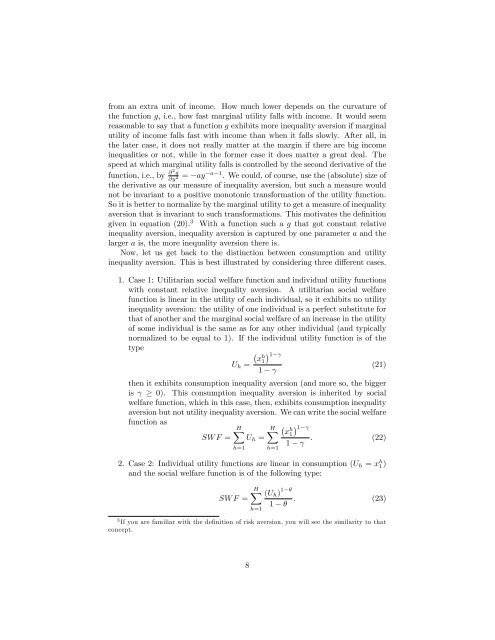Lecture Note 15: Social Cost Benefit Analysis - University of ...
Lecture Note 15: Social Cost Benefit Analysis - University of ...
Lecture Note 15: Social Cost Benefit Analysis - University of ...
You also want an ePaper? Increase the reach of your titles
YUMPU automatically turns print PDFs into web optimized ePapers that Google loves.
from an extra unit <strong>of</strong> income. How much lower depends on the curvature <strong>of</strong><br />
the function g, i.e., how fast marginal utility falls with income. It would seem<br />
reasonable to say that a function g exhibits more inequality aversion if marginal<br />
utility <strong>of</strong> income falls fast with income than when it falls slowly. After all, in<br />
the later case, it does not really matter at the margin if there are big income<br />
inequalities or not, while in the former case it does matter a great deal. The<br />
speed at which marginal utility falls is controlled by the second derivative <strong>of</strong> the<br />
function, i.e., by @2 g<br />
@y 2 = ay a 1 . We could, <strong>of</strong> course, use the (absolute) size <strong>of</strong><br />
the derivative as our measure <strong>of</strong> inequality aversion, but such a measure would<br />
not be invariant to a positive monotonic transformation <strong>of</strong> the utility function.<br />
So it is better to normalize by the marginal utility to get a measure <strong>of</strong> inequality<br />
aversion that is invariant to such transformations. This motivates the de…nition<br />
given in equation (20). 3 With a function such a g that got constant relative<br />
inequality aversion, inequality aversion is captured by one parameter a and the<br />
larger a is, the more inequality aversion there is.<br />
Now, let us get back to the distinction between consumption and utility<br />
inequality aversion. This is best illustrated by considering three di¤erent cases.<br />
1. Case 1: Utilitarian social welfare function and individual utility functions<br />
with constant relative inequality aversion. A utilitarian social welfare<br />
function is linear in the utility <strong>of</strong> each individual, so it exhibits no utility<br />
inequality aversion: the utility <strong>of</strong> one individual is a perfect substitute for<br />
that <strong>of</strong> another and the marginal social welfare <strong>of</strong> an increase in the utility<br />
<strong>of</strong> some individual is the same as for any other individual (and typically<br />
normalized to be equal to 1). If the individual utility function is <strong>of</strong> the<br />
type<br />
Uh = xh 1<br />
1<br />
1<br />
(21)<br />
then it exhibits consumption inequality aversion (and more so, the bigger<br />
is 0). This consumption inequality aversion is inherited by social<br />
welfare function, which in this case, then, exhibits consumption inequality<br />
aversion but not utility inequality aversion. We can write the social welfare<br />
function as<br />
HX HX<br />
SW F = Uh =<br />
xh 1<br />
1<br />
1<br />
: (22)<br />
h=1<br />
2. Case 2: Individual utility functions are linear in consumption (Uh = x h 1)<br />
and the social welfare function is <strong>of</strong> the following type:<br />
SW F =<br />
h=1<br />
HX (Uh) 1<br />
h=1<br />
1<br />
: (23)<br />
3 If you are familiar with the de…nition <strong>of</strong> risk aversion, you will see the similarity to that<br />
concept.<br />
8


